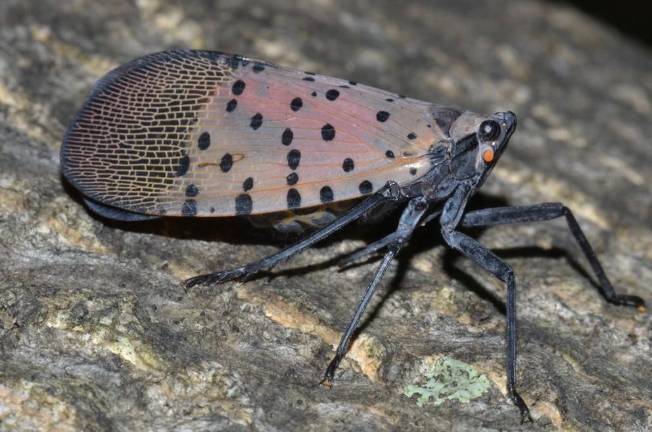All-out effort needed to combat spotted lanternfly in Pa

(AP) Pennsylvania's status as the epicenter of a spotted lanternfly invasion -- a hungry pest that found its way here from Asia -- is much more than a backyard annoyance or an extra spraying chore for farmers. It has developed into a serious economic threat to vineyards, orchards, nurseries and hardwood trees in southeast and central Pennsylvania, including Lehigh, Northampton, Bucks and Monroe counties.The discovery of the non-native insect in Berks County in 2014 was cause for alarm. Its spread since then has generated a call to arms by the state Department of Agriculture, Penn State Extension and business owners, as it defies quarantines and other tactics to prevent its expansion.
The lanternfly is particularly damaging to grape vines, having all but wiped out some vineyards in affected counties. The vivid red, black and white-colored fly is most harmful in its immature stages. That's when it attacks grape vines, fruit trees and hardwood trees, sucking out fluids and secreting a substance that leads to mold growth, also a threat to plants.
Homeowners can join the fight -- by killing adult flies and removing egg masses that show up in autumn months. They should also take care not to transport flies or eggs in vehicles, by moving grills, lawnmowers, firewood, landscaping tools, bicycles and other things that could be infested. Sticky traps can be placed around tree trunks. Simply swatting the flies to kill them is encouraged, too, along with reporting sightings to 1-888-4BAD-FLY. The state Agriculture Department and Penn State Extension are good sources of information on techniques, sprays and other methods of defense.
At the state level, Gov. Tom Wolf has approved spending $3 million this year to try to contain the bug. The infestation is perceived as a potentially existential threat to producers in the $20.5 million-plus grape, nearly $134 million apple and more than $24 million stone fruit industries, as well to a hardwood industry that accounts for $12 billion in sales, according to the state Department of Agriculture.
The state has initiated a free permitting system for businesses, to prevent the spread of the lanternfly through commerce in the quarantined areas, which includes the Lehigh Valley.
There is hope that science, government and people working together can turn the tide. The battle against the once-prevalent gypsy moth caterpillar is still being fought, but it isn't the threat it once was. Continued spraying for black flies has made outdoor activities more bearable for people who live near wetlands and waterways.
Experts are working to develop counter-measures. Researchers at Cornell University recently reported some progress in using native fungal pathogens against the spotted lanternfly.
Still, we shouldn't be content to leave this battle to the experts. Pennsylvanians in infested areas need to get educated and get involved.
Easton Express-Times